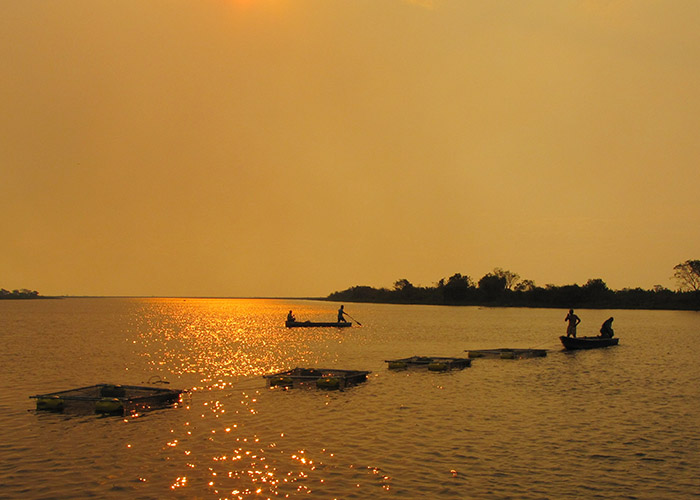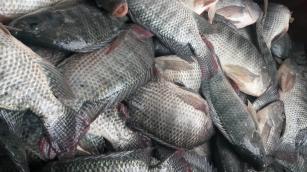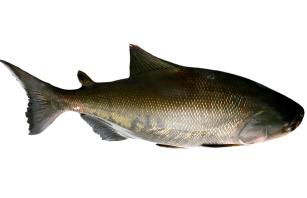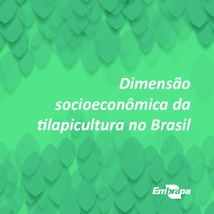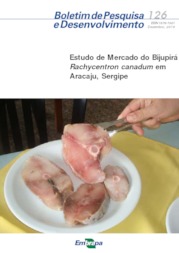Embrapa Wheat
Notícias
Brazil starts the biggest research project ever elaborated to develop aquaculture
The largest research project on aquaculture ever held in Brazil was initiated. BRS Aqua involves 22 research centers, 50 public partners and 11 private companies - figures that should increase as the project goes on. A true landmark in investments on the theme, fruit of the partnership between Embrapa, the Brazilian National Economic and Social Development Bank (BNDES), National Council of Scientific and Technological Development (CNPq) and the current Special Secretariat of Aquaculture and Fishery, under the Presidency of the Republic (SEAP).
The project is the third largest one ever funded by BNDES Funtec - non-reimbursable credit line for applied research, technological development and innovation projects. A total of R$57 million in funds will be allocated: R$ 45 million from the state bank, R$ 6 million from Embrapa and R$ 6 million from the Special Secretariat of Aquaculture and Fisheries. The goal, at the end of the four years it is due to last, is to establish the infrastructure and the scientific research required to meet the demands of the aquacultural market.
“This project is of major importance not only for our research center, but also for the entire Embrapa and for Brazil. It is the evidence that aquaculture is here to stay and has become a strategic area in the country”, celebrates Eric Arthur Bastos Routledge, head of Research and Development of Embrapa Fishery and Aquaculture, the unit that coordinates BRS Aqua.
Four species to be studied
In Brazil, one of the biggest challenges in aquaculture is in the lack of technological apparatus to breed important aquacultural species. Therefore, the project will focus on researching tambaqui (Colossoma macropomum), tilapia (Oreochromis niloticus), shrimp (Litopenaeus vannamei) and cobia (Rachycentron canadum), which either have large market demand or high productivity potential.
“These species are found at different technological levels and for each one of them there will be a different approach”, explains the project researcher and coordinator, Lícia Maria Lundstedt, from Embrapa Fishery and Aquaculture. According to it, while tilapia has a more advanced technology pack, research with cobia is still incipient in the country, in spite of being native to the Brazilian coast and having potential to be an option for the development of national sea fish farming.
Researcher Lícia Lundstedt talks about the BRS Aqua project at the show Conexão Ciência
Reinforced research infrastructure
“Each of these species could yield several projects by themselves. In any case, BRS Aqua is going to generate several products, including an increment to the infrastructure for future research in aquaculture at Embrapa”, Lundstedt explains. Embrapa Coastal Tablelands, for instance, will have a new laboratory to research sea species; Embrapa Mid-North, which already works with shrimp, will also have research facilities in the area improved, and several other Embrapa units will receive a reinforcement in their infrastructure to develop research in aquaculture.
To meet the most different demands, BRS Aqua works as a large umbrella under which there are eight component projects (Germplasm, Nutrition, Health, Environmental management, Fish Technology, Economy of the Aquacultural Sector, Technology Transfer and Management), with research distributed throughout several of Embrapa's research centers and producing regions.
Establishment of a gene bank
“One of the features in genetics is the generation of scientific and technological information that has direct impact in the production of tambaqui fry (young fish) with better quality, which will entail reduced mortality and increased production”, Lundstedt explains, adding that the project intends to establish a qualified tambaqui germplasm collection at Embrapa Fishery and Aquaculture for future public or private investment in breeding and genetic improvement.
According to the researcher, the tambaqui production sector currently uses scientifically little characterized germplasm without genetic improvement. In order to push production forward, germplasm needs to be genetically improved in terms of production traits like improved growth rates, greater resistance to diseases, adaptation to intensive cropping systems, among other adjustments.
In health, the project intends to map the most important tambaqui health challenges and risk factors in order to propose best management practices, quick diagnosis systems and develop respective treatments. One of the main results in this area will be the identification of the risk factors related to shrimp mortality caused by the white spot syndrome virus (WSSV), in order to consider measures to prevent or mitigate effects in production in the Brazilian Northeast.
White spot syndrome is manifested at the crustacean's early stages of development, calcifying it, causing lack of appetite, lethargy and white spots in its shell. Then the animal dies and contaminates others. Hence the entire production is lost before it even reaches the consumer. One of the most recent cases of the disease occurred in Ceará state in the middle of 2017. In six months, 30,000 tons of shrimp were lost - the equivalent to 60% of the production in the period.
In nutrition, the focus will be on tambaqui and tilapia. The project will define dietary protocols for intensive tambaqui production, at the stages of larva, fattening and slaughter, in fisheries and net pens, based on their capacity to digest feed ingredients and the fish's nutritional requirements. Moreover, the project will address aspects related to the feed processing technology, once there are several parameters that need to be carefully monitored to obtain high quality products. The feed available in the market will be nutritionally assessed. It is precisely this input that impacts up to 82% of the production costs, depending on the adopted system. In practice, the farmer ends up spending more than necessary to fatten the animal.
Climate change and fish farming
Issues related to global warming and environmental sustainability are equally in the project's radar, which establishes the development of equipment to monitor the release of greenhouse gases in fish farming. The analysis of the relationship between production in net pens, greenhouse gas emissions and the quality of the water. The observation of physical, chemical and biological variables of sediments and water, including soil contamination and treatment of effluents generated by fish production, will also be the target of studies. Similarly, a system to treat effluents from fish production will be developed.
New fish products
BRS Aqua is also going to work on different aspects related to fish processing. The project is going to work in the development of technological solutions for efficient and humane slaughter of fish, steak standardization and quality control, use of waste and processing co-products from the elaboration of added-value materials. Similarly, there will be a study of models for the management of solid waste in the fish processing industry.
On top of the technological bottlenecks, Brazilian aquaculture also lacks data and economic analyses. “Because we are dealing with a relatively recent sector, when compared to traditional agroindustrial chains such as those for other meats or grains, there is little information about several aspects of the fish chain”, justifies the Embrapa researcher Manoel Xavier Pedroza Filho, responsible for the economy segment of the project. According to him, it is missing data on the economic-financial viability of the crop systems, structure of the production chain, risk of investment, economic impact of the adoption of technologies, as well as macroeconomic data about national aquaculture (jobs, GDP, etc).
“The absence of such information makes decision-making difficult in the public and private sectors, once it is fundamental not only to guide investments, but also to inform the formulation of public policy for the sector”, the specialist underscores. BRS Aqua intends to generate economic information about the four species the project comprises, through analyses of the economic viability of production systems, impact of the adoption of technologies, risk of investment, and others.
Great national potential
Despite having 12% of the world's freshwater and an 8,500-km coastline, the Brazilian production of aquatic animals is inferior to its potential. There are many causes for this performance and they include low quality of mothers; few studies on the support capacity of crop environments (ideal maximum number of fish for a given area); limited technical assistance; deficient forms of aquatic animal disease control and monitoring; incipient use of waste to produce byproducts; lack of treatment and exploitation of effluents from aquaculture, and lack of standardized indicators for environmental licensing in the different environments where aquaculture is practised.
“We surveyed information about the sector between 2012 and 2013, which generated two studies that revealed the potential in the area of aquaculture in Brazil. This was at the time there was a Ministry of Fishery and Aquaculture, which aimed at investing in aquacultural development”, recalls Marcos Rossi Martins, head of the Department of the Area of Industry and Services at BNDES.
The analysis identified large bottlenecks and opportunities. The variety of fish in the Amazon River Basin, for example, is a differential Brazil should explore to reach new markets. The climate is another advantage in favor of the country, whose conditions to cultivate tilapia - one of the most consumed fish species in the world - are excellent. Other cultivations, such as shellfish, also have potential for scale in Brazil. However, the fish industry is still incipient in the country, both in fisheries and in aquaculture.
According to data from a 2014 report by the United Nations Food and Agriculture Organization (FAO/UN), world consumption in aquaculture is on the order of 20 kg per capita, while beef is less than half of that: 6.54 kg. In this scenario it is easy to reckon how promising the market for fisheries and aquaculture is in the country.
“The world demand for fish has been growing rapidly as result of the population increase and the pursuit for healthier foods. In Brazil this has also occurred. In 2003, consumption was lower than 6.5 kilos of fish per person per year, an amount that has risen to nine kilos per capita nowadays. If the population ingested the amount recommended by WHO, which is 12 kilos, that would represent an impact in consumption of 5,722,000 tons”, estimates Jaldir Lima, one of the coordinators of the BNDES study.
Expectation of improved competitiveness
The project was also well received by representatives of the production sector. For Antonio Albuquerque, technical director of the Ceará Association of Shrimp Breeders (ACCC), it is a sign that the research is attentive to market demands. “This Embrapa initiative of listening to several stakeholders, including other production chains, to learn what the main demands are, is very positive. It is also very useful that the research knows what kind of support the production sector can give”, he says.
Francisco Medeiros, president of the Brazilian Association of Fish Farming, Peixe BR, has many expectations. “We have been following the elaboration of this proposal since 2015. It is a sector that needs solutions that offer higher competitiveness. In Brazil, we have great researchers in aquaculture, however, we have observed a low use of the technologies generated by research institutions”, he analyzes. “We have a big problem of competitiveness and hope that all these actions bring solutions that promote better market conditions. We are going to follow the execution of this work closely”, he summarizes.
Translation: Mariana Medeiros
Elisângela Santos (MTb 19.500/RJ)
Embrapa Fishery and Aquaculture
Press inquiries
pesca-e-aquicultura.imprensa@embrapa.br
Phone number: (63) 3229-7834
Further information on the topic
Citizen Attention Service (SAC)
www.embrapa.br/contact-us/sac/

